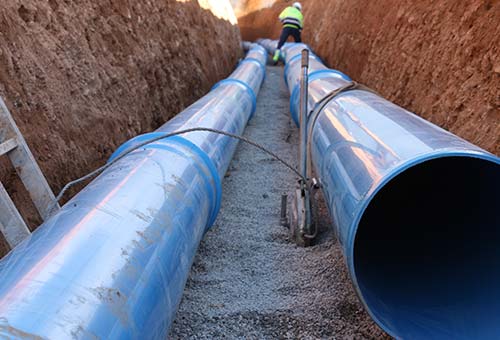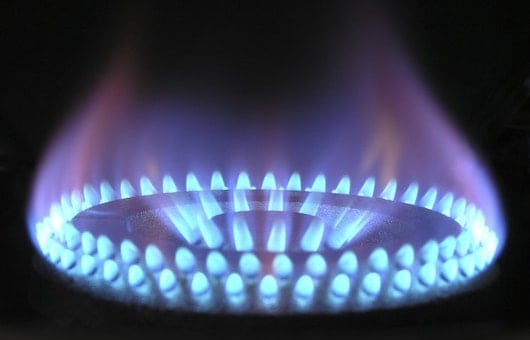PVC pipes are generally categorised into four: PVC-U unplasticised PVC), C-PVC (chlorinated PVC), PVC-O (molecular oriented PVC) and modified PVC. Besides sharing many of the same properties, each type of PVC has its own advantages for different applications.
PVC-U
PVC-U or U-PVC stands for unplasticised PVC, which means no plasticiser (US: plasticizer) has been added to the PVC compound. Unplasticised PVC is also known as rigid PVC. PVC-U is the most common PVC type for pipes and fittings including transportation of drinking water, soil and waste, sewage and underground drainage and industrial applications.
Pipes and fittings made of PVC-U have many benefits. They are a safe choice for transportation of drinking water, light and easy to handle and affordable. Technical properties include high mechanical performance, high durability (at least 100 years for underground pipes), high chemical resistance and resistance to UV exposure. Moreover, PVC-U pipes have favorable environmental profiles and are 100% recyclable.

PVC-U is the most common PVC type for pipes and fittings
C-PVC
C-PVC or PVC-C stands for chlorinated PVC. Pipes and fittings made of C-PVC share many of PVC-U's advantages. Both are safe for use with drinking water, have high resistance to corrosion, high durability and excellent impact resistance. However, with its higher chlorine content than regular PVC-U, pipes and fittings made of C-PVC can withstand a wider range of temperatures. This has made C-PVC a popular choice for water piping systems in residential as well as commercial construction. C-PVC is also significantly more ductile than PVC-U. Pipes and fittings made of C-PVC are 100% recyclable.

C-PVC is typically used for pipes and fittings for hot and cold water
PVC-O
Molecularly oriented PVC (PVC-O) is the result of a production process that turns the amorphous structure of unplasticised PVC (PVC-U) into a layered structure.PVC-O enhances the many benefits of PVC-U such as resistance to corrosion, preservation of water quality, cost-efficiency and recyclability and an unsurpassed balance between strength, stiffness and flexibility. Pipes made of PVC-O are especially advantageous when it comes to hydraulic capacity, ductility, crack propagation and impact and fatigue resistance. This means that PVC-O is an excellent choice for pressure pipes for drinking water. PVC-O is also well suited for buried non-potable applications such as irrigation and sewer pumping mains. PVC-O pipes and fittings are 100% recyclable.

PVC-O is typically used for pressure pipes for drinking water
Modified PVC (PVC-M, PVC-HI, PVC-A)
This family are thermoplastic alloys formed by the addition of compatible modifying agents to PVC. The modifying agents improve toughness, impact properties and resistance to crack growth that improves the fracture toughness and ductility of the material. This enhanced toughness enables modified PVC pipes to be manufactured with a thinner wall, with subsequent material savings and improved hydraulic properties. The alloying of PVC with modifying polymers achieves improvement in resistance to cracking. The result is the minimisation of the effect of stress concentrators such as scratches.
About PVC-HI
PVC-HI stands for High Impact PVC. The PVC-HI grade is obtained by adding an impact modifier to PVC-U that increases the resistance of the pipes to external blows.
The minimum requirements for a PVC-HI grade is precisely defined in section 5 of the international standard ISO 6993-1 “Buried, high-impact poly(vinyl chloride) (PVC-HI) piping systems for the supply of gaseous fuels — Part 1: Pipes for a maximum operating pressure of 1 bar (100 kPa)”:
- Composition: PVC-HI shall be one of the following compositions:
- a mixture based on PVC
- a blend based on PVC
- a copolymer based on PVC
- a combination of these types
- Long term strength: The MRS value of PVC-HI shall be at least 18 MPa. Conformity to this requirement shall be proven using a long-term evaluation in accordance with ISO 9080. Testing shall be carried out at 20 °C, 40 °C and 60 °C, for periods up to 9 000 h. At 60 °C no knee shall occur before 5,000 h
- Vicat softening temperature: The Vicat softening temperature of PVC-HI shall be at least 76 °C
- K-value: The PVC-U used to make PVC-HI shall be at least 65
- Impact resistance after UV weathering: UV weathered pipe specimen of PVC-HI should not break when a striker of a defined mass is launched from a defined height
- Resistance to gas constituents: no crazes of a depth greater than 30 µm should be observed in pipe specimen of PVC-HI exposed to tetrahydrothiophene and n-hexadecane

PVC-HI is a material of choice for natural gas networks
PVC-HI transport natural gas – and is fit for hydrogen
PVC-HI is how the material should be designated when a pipe comply with ISO 6993-1 (see section 12 of the standard). This grade is the only accepted since the late 70s for pipes supplying natural gas. 60,000 km of PVC-HI pipes are installed in the Netherlands only


